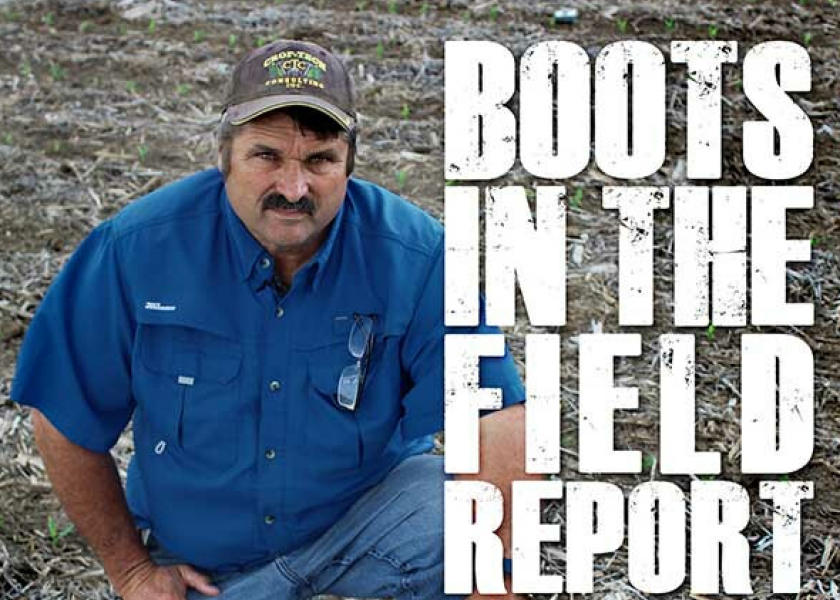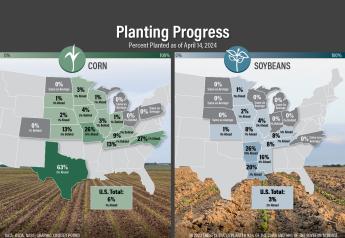Ferrie: It’s Go-Time for Hybrid Selections and Anhydrous Applications

Temperatures have backed off substantially in central Illinois and other parts of the upper Midwest, with farmers rolling through fields now making anhydrous applications.
Ken Ferrie says farmers have been calling him to find out what works best – to chisel first and then apply anhydrous or the other way around?
“I would pull the gas first, wait a couple days and then start the chiseling,” says Ferrie, Farm Journal Field Agronomist.
Doing the opposite – applying anhydrous ammonia after chiseling – can leave some fairly deep tank tracks in the field, and they're hard to get out, Ferrie says, especially in vertical tillage.
Moisture levels are good in many areas, so farmers should be getting a good seal on their applications. Even so, he recommends using the smell test to confirm.
“When that toolbar goes by, have someone get down on their knees and smell that trench,” he advises. “If there’s no odor out of there it’s sealing. If the sniffer’s gagging for oxygen you're not sealing. Do the same sniff test when you start chisel plowing,” he adds.
Fungicides Paid To Apply In ‘Tar Spot Alley’
Ferrie says a fungicide plot harvested in northeast Iowa this past week showed it delivered on yield in an area he refers to as the 2022 season’s tar spot alley.
“The response to one pass with a fungicide was right at or a little over 50 bushel and a noticeable difference in stalk quality,” he says.
The plot demonstrated how devastating tar spot can be once it gets cranked up in an area. The disease had just begun to move into the area last fall, in most cases too late to cause significant damage to the 2021 crop. That wasn’t the case in 2022.
“Heavy rains this season caused last year's blown-in tar spot to be this year's homegrown tar spot problem,” Ferrie says. “Northeast Iowa saw some of the same aerial application streaks that we were dealing with in central Illinois last year. A big thanks to Mike and Alan Harbor who helped us set up this plot as we continue to try to get our arms around this beast so we know how to manage it.”
Ear-Flex Test Plots Showcase Hybrid Characteristics
Ferrie provided updates in this week’s Boots In The Field podcast on two Illinois ear-flex plots harvested near Milford, in Iroquois County and in LaSalle County, near Streator. You can hear it here:
The plot in the Milford area contained 27 hybrids, which were planted at 24,000 and 36,000 populations.
Hybrids planted at 36,000 had a yield range from 243 to 278 bu. per acre. The average was 264 bu.
The same hybrids planted at 24,000 population had a yield range of 207 to 267 bu. per acre, with an average of 248 bushels.
“Of the 27 hybrids, one hybrid yielded the same at 24,000 population as it did at 36,000, and one hybrid yielded higher at 24,000 than at 36,000,” Ferrie reports. “The rest responded more positive to the higher population.”
The plot in the Streator area contained 16 hybrids planted in twin rows at 24,000 and 38,000 population.
“It had some interesting results,” Ferrie says. “This plot was rolled up for three weeks this summer prior to tasseling. But it finished with plenty of water the rest of the season.”
At the 38,000 planted population, Ferrie saw a yield range from 240 to 277 bu. per acre with an average of 257 bu.
At the 24,000 planted population, there was a yield range of 247 to 278 bu. per acre with an average of 264 bu.
“We had nine entries that yielded more at 24,000 than at 38,000,” he says. “One entry was equal and the rest did better at 38.”
Making Sense Of Test Plot Yield Results
Ferrie says the yield results in the Streator test plot would make more sense if yields had run in the 180- to 200-bu. range and if season-long drought had occurred.
“In those conditions, high population can overstress the hybrid, allowing lower populations to show better,” he explains.
However, that was not the case as the plot was not enduring a season-long drought. Instead, Ferrie says it was hit by what he calls a short flash drought.
“This plot really brought the hybrid characteristics to the forefront and how they play out during the growing season,” he says “What’s showing up this year is that flash drought caught some of the L1 hybrids.”
“L1 hybrids are those that can flex down in ear size cob and all. They were stressed during that rapid growth period from V7 to tasseling, and that’s when this shutdown would have taken place,” Ferrie adds.
Corn in the Streator area was rolled up for three or more weeks during the rapid growth period. Yet most of the corn was still able to grow during the evening hours.
“At that time, I believed we probably didn't have a lot of damage going on to yield. But with some of the L1 hybrids, conditions were actually dry enough to flex the ears down,” Ferrie says.
At the 38,000 population, even though the hybrids were planted in twin rows, that was high enough to trigger the ears to shorten up. But the same hybrids planted at the 24,000 population didn't receive the same level of stress, and they kept their ear length.
Once the rains began to fall, it was too late for the L1 hybrids at the 38,000 population, as they had already aborted their ear length.
“Now while these hybrids could make some of that loss back in depth, especially if they were an L1-D hybrid, they could not make up the total loss that they experienced from flexing those ears down,” Ferrie says.
Consider How You Can Mitigate Risk For Next Season
What do these test plot results mean for farmers making plans for 2023? While you can’t plan for a flash drought, you can mitigate some risk by diversifying hybrid characteristics.
“Some growers will throw a hybrid out of their lineup this year based on one year of poor performance, not realizing weather conditions caught that hybrid in its weak spot,” Ferrie says. “Consider that this still may be one of your best hybrid choices for your farm year in year out, but this year just wasn't its year.”
Farmers tend to like planting one year’s winning hybrids the following season, but that’s not a good strategy.
“If we don't understand hybrids and their characteristics -- and what causes them to win or lose -- we end up just swinging back and forth trying to find that silver bullet,” Ferrie says. “Instead, keep next year's lineup diverse and know your hybrids’ weaknesses, so you can farm around them.”
2022 Farm Journal Test Plots Early Results
Agronomic Phenomenon in Corn Strikes Outer Rows of Fields, Strips Yield
Rural Bankers Share Predictions on Farmland Values, Recession and the Economy







